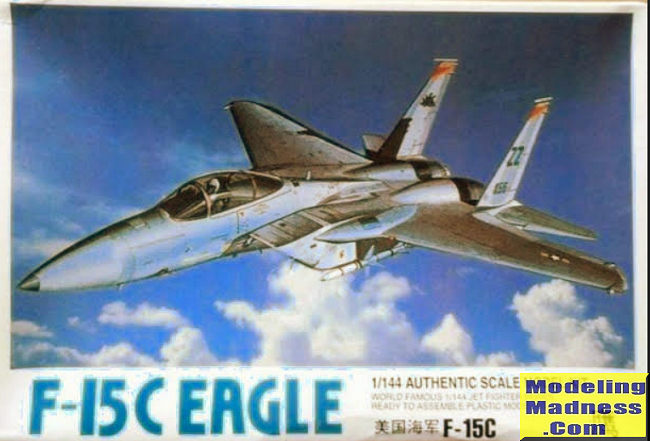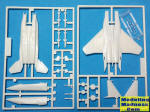
CC Lee 1/144 F-15C Eagle
| KIT #: | 02205 |
| PRICE: | Less than $5.00 |
| DECALS: | One option |
| REVIEWER: | Spiros Pendedekas |
| NOTES: |

| HISTORY |
First flown in July 1972 and entering service in 1976, the twin engine F-15 Eagle is among the most successful modern fighters, with over 100 victories and no losses in aerial combat. As of 2023, the type is in service with various countries, with production of enhanced variants continuing!
| THE KIT |
 CC
Lee came sometime in the 90s with their very cheap 1/144 F-15C, a kit which, by
examining the sprues, looks to be a direct copy of the 1974 Otaki mold, the
latter being reboxed or copied a surprising number of times by many companies
through the years. The specific kit looks to be the initial edition and was
given as a gift by my small local modeling club to my young sons in Christmas
2023. The kit comes in a small, good quality, top opening box, carrying the same
attractive box art of the 1992 Arii edition of this mold.
CC
Lee came sometime in the 90s with their very cheap 1/144 F-15C, a kit which, by
examining the sprues, looks to be a direct copy of the 1974 Otaki mold, the
latter being reboxed or copied a surprising number of times by many companies
through the years. The specific kit looks to be the initial edition and was
given as a gift by my small local modeling club to my young sons in Christmas
2023. The kit comes in a small, good quality, top opening box, carrying the same
attractive box art of the 1992 Arii edition of this mold.
Upon opening the box, I was greeted with 22 white styrene parts arranged in two
equally sized sprues. Molding is acceptable, not too crisp and with little
flash. General shapes of parts look correct, with the exception of an easily
shaved-off dorsal filet that is not present in reality. Panel lines are recessed
but way off-scale. The front part of the fuselage is split vertically, whereas
the rear section, containing the wings and tail planes, is split vertically.
There is no cockpit to speak of, just a recession which better be painted black.
Landing gear is simplistic with shallow bays and the exhaust nozzles are equally
plain. The intakes are practically oversimplified recessions. The canopy is
relatively well molded and very thick, the latter being in this case an
"advantage", as it will hopefully distort the cockpit's emptiness towards
"vagueness".
 Instructions,
also a copy of the Arii ones, come in the form of a b/w double printed small
sheet, with the 4-step simple construction on the one side and the painting
guide on the other. One scheme is provided, for a 18 TFS, 12 TFW machine. Decals
are not that sharply printed, but they otherwise look in good condition.
Instructions,
also a copy of the Arii ones, come in the form of a b/w double printed small
sheet, with the 4-step simple construction on the one side and the painting
guide on the other. One scheme is provided, for a 18 TFS, 12 TFW machine. Decals
are not that sharply printed, but they otherwise look in good condition.
Instructions want you to first assemble the front and rear fuselage sections and
then join them, followed by the canopy. You are supposed to trap two styrene
rods at the front, presumably to avoid tail sitting: I would add some fishing
weights instead. Next is attachment of the twin fins and exhaust nozzles,
followed by the landing gear and the four Sparrows, ending a very easy build.
| CONCLUSIONS |
This is an elderly, simplistic kit of the iconic Eagle. While general
shape is good, detail at key areas varies from toy-ish (landing gear) to
nonexistent (cockpit).
That said, there is nothing wrong in spending an afternoon putting together this
kit, with the ease of construction deeming it suitable for younger,
inexperienced modelers, as they enter the magic world of modeling.
Happy Modeling!
January 2024
Copyright ModelingMadness.com. All rights reserved. No reproduction in part or in whole without express permission.
If you would like your product reviewed fairly and fairly quickly, please contact the editor or see other details in the Note to Contributors.